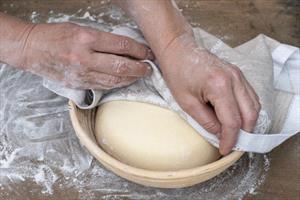Raw yeast dough

Photo courtesy of Depositphotos
If you bake yeast bread from scratch, it is essential that you keep all raw bread dough away from your pets. Ingesting it can cause serious problems and be life threatening for your pet.
Doughs that do not contain yeast are less of a concern, but can still cause gastrointestinal problems.
Why is it so dangerous to eat?
Yeast is a microscopic fungus that, under the right conditions, makes carbon dioxide gas and ethanol (alcohol) from sugar. This effect is great for making bread because gas makes the dough rise and ethanol flavors the bread before burning off in the oven. However, this process is dangerous when it occurs in your animal's stomach.
Being moist and warm, the stomach is essentially the perfect environment for yeast to grow and pump out carbon dioxide and ethanol. The buildup of gas and rising dough in the stomach is painful and can lead to a condition called bloat: “the mother of all emergencies.” Also known as gastric dilatation and volvulus, or GDV, bloat is where the expanding stomach puts pressure on surrounding areas and decreases blood flow to important organs. Even more dangerous, the stomach may eventually twist, cutting off blood flow even more. The twisted stomach can reduce blood flow throughout the whole body, leading to a serious condition called shock.
Several steps are needed to save a bloated dog’s life. Part of the problem is that the main three steps - decompress the stomach, give IV fluids to fight shock, and stabilize the heart rhythm - should all be done at the same time and as quickly as possible.
Although GDV can be life threatening, death from yeast dough in pets is usually due to the effects of ethanol. Ethanol is alcohol, like that found in beer, wine and spirits, so the ethanol produced by yeast can cause alcohol poisoning. This poisoning can lead to low blood sugar, low blood pressure, decreased body temperature, seizures and trouble breathing.
Signs
Early signs of yeast dough ingestion are generally those associated with bloat. Your pet may try to vomit or retch but not produce anything or maybe just a little white foam. Additional signs include an enlarged abdomen due to the buildup of gas and dough, in addition to weakness, increased heart rate, and collapse.
Signs of alcohol poisoning generally occur two or more hours after dough is ingested. You might be able to smell alcohol on your pet's breath. Your pet may seem drunk, becoming uncoordinated and disoriented. They may also feel cold to the touch. Seizures and trouble breathing are two other serious signs of alcohol poisoning.
What should I Do?
Get to a veterinarian as soon as possible, as this is potentially a life-threatening emergency.
If your pet just recently ate the dough and isn't showing any symptoms yet, your veterinarian may try to induce vomiting to remove it from the stomach. As you can imagine, bread dough is so gummy and sticky that it is hard to vomit up. So, other methods of removal will likely be necessary.
Yeast love the warmth in a stomach. If you make the stomach cold, you can slow the yeast's growth and the production of alcohol and gas. This slow down can be accomplished by feeding ice chips or flushing the stomach with cold water. These treatments can also break up the dough and make it easier to pass through the rest of the digestive system. In rare cases, the dough may need to be surgically removed.
Treatment also involves dealing with your pet's specific clinical signs and may entail giving intravenous fluids to correct any blood abnormalities and to speed up removing alcohol from the bloodstream. If your pet is cold, heating blankets, warm intravenous fluids and other techniques may be used to warm them up. Depending on your pet's symptoms, medications may be given to reduce pain, treat seizures, correct breathing abnormalities, manage vomiting, etc.
The veterinarian will need to monitor your pet for at least 12 hours until they recover.
Prognosis
Pets generally do well if the yeast dough is removed quickly and they are treated soon after ingestion. Unfortunately, pets suffering from severe alcohol poisoning, bloat, or GDV have a more guarded prognosis.
To prevent this life-threatening situation altogether, avoid letting your pets have access to raw yeast dough by letting it rise in areas your pets can't reach, such as elevated places in the kitchen, or in a closed oven or microwave.